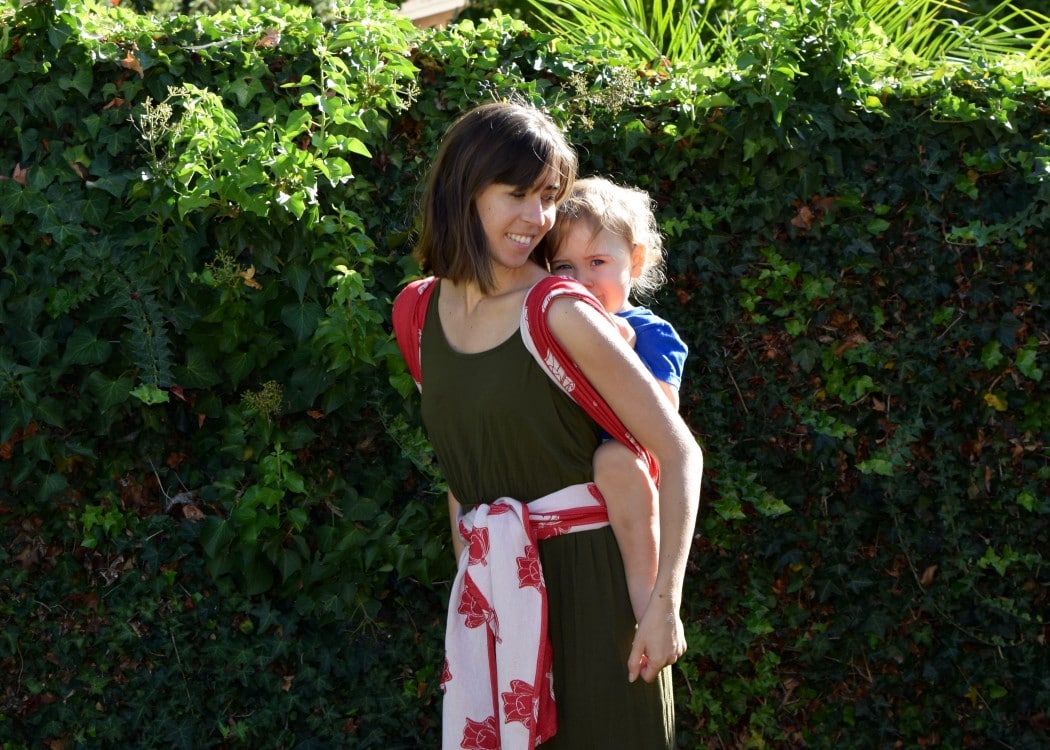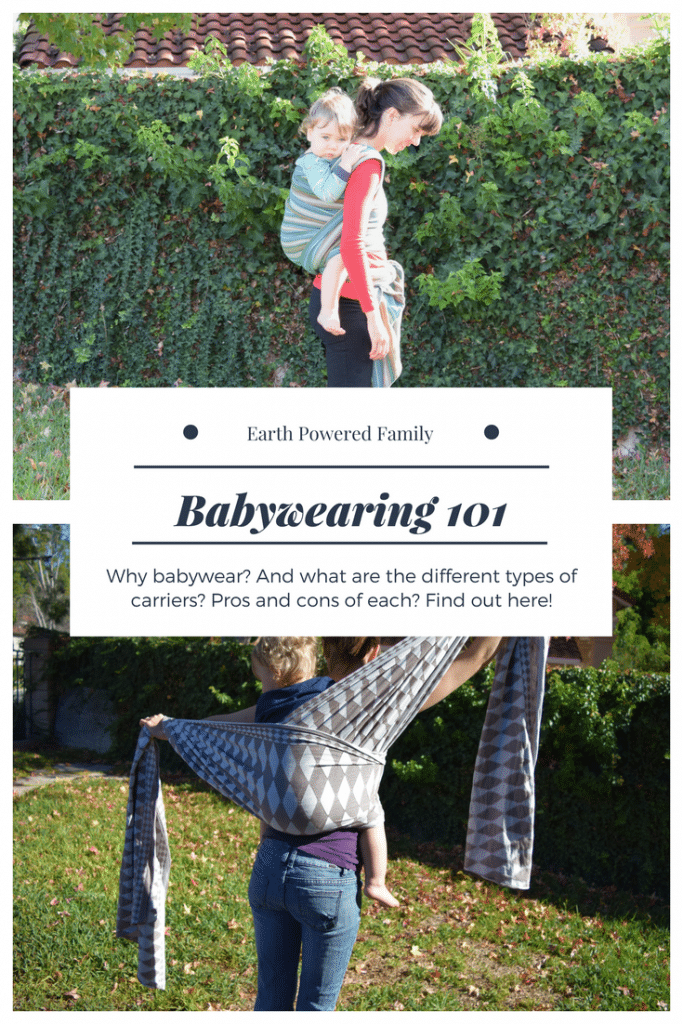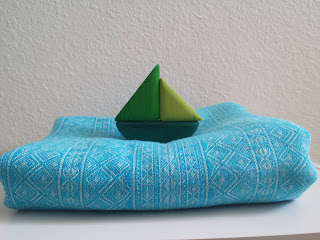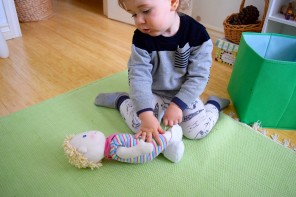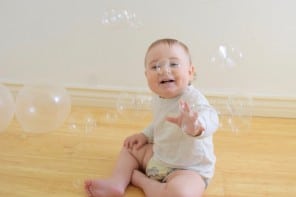Babywearing 101
Up until several years ago, I really didn’t know very much about babywearing. I had seen some people use Baby Bjorns or the huge hiking carriers, but not very many. The vast majority of people with babies and toddlers used strollers, carseats, shopping cart seats, or even wagons to tote them around. But in recent years, I noticed more people had their babies snuggled close to them in a carrier. When I became pregnant, I knew babywearing was something I wanted to try because it seemed so much nicer. Plus, my crunchy instincts told me it had to be better for the baby. But there are SO. MANY. CHOICES. It was very overwhelming, and I feel like I spent hours just trying to figure out the differences between carriers before even choosing one. So here’s a crash course on the basics of babywearing.
Why babywear?
Babies are meant to be held. Humans have not always had strollers and carseats and cribs. When babies are born, they are going from a safe, warm, and dark place to somewhere much colder and stimulating. In fact, the weeks after birth are referred to as the “fourth trimester”. Human babies are born still completely dependent on their caregiver. Babywearing helps to give babies a sense of security and keeps them from becoming overwhelmed. Everything about you, your heartbeat, smell, the feel of your skin, the rhythm of your breathing, all help to keep your infants body physically regulated. Plus, when you move, you are helping their vestibular system (what helps them move and balance) develop properly. Keeping them upright in a carrier can also help with digestion and ease symptoms of colic. Especially since the “back to sleep” initiative (which has saved many lives), there are more babies developing flat spots on the back of their heads. Babywearing can help to alleviate this. And when you need a luxury like food or brushed teeth, it keeps your hands free! It was so nice to be able to get basic things done around the house when Dominik only wanted to be held.
And finally…. babywearing snuggles are amazing. Having your child snuggled close is probably the greatest feeling in the world.
Babywearing safely:
Tiny humans are vulnerable and it’s important that babywearing is done safely. Newborns can fold their chins forward onto their chest, which cuts off their breathing. And there of course is always the risk of an unsafe carrier and carry. Steer clear of homemade carriers and poorly made ones like fake ergos (which are sold on Amazon, beware). Stick to reputable sources and carriers that have been safety tested. There are a few rules and guidelines that will keep your little one safe. They go by the acronym T.I.C.K.S.
Tight
In view at all times
Close enough to kiss
Keep chin off chest
Supported back
Types of carriers:
Soft structured carrier:
 |
| Tula |
These are the most common and probably the easiest the use. I’ve seen people refer to them as SSCs or “buckles”. It’s basically a panel with straps and a waistband that use buckles to adjust the size. They are straightforward to use, comfortable, and awesome for a quick “up”. Because the size of the panel is generally a “one size fits most”, newborns and smaller babies need to use an insert in order to fit safely. Newborns lack head and body control and tend to slump down into the carrier. This can cut off the air supply for them, so it’s very important that newborns are properly secured when using a buckled carrier. A rolled up receiving blanket or towel can be used under the babies bottom to help secure them if an insert is not used.
They make these in toddler and preschooler sizes as well so it’s a great option that will last. The manufacturer will be clear on which carries are safe with the particular model, but many models can also be used for forward facing, hip carries, and back carries.
Pros:
-easy to use
-widely available from multiple stores
-affordable options
-quick babywearing option
-distributes weight well on the hips and shoulders
-no worries about dragging on the ground
-a great option for warm weather
Cons:
-sometimes can be hard to get a good fit to the wearer (some people with long or short torsos have trouble finding one that fits, regardless of the adjustable straps)
-with frequent wearing and washing, they wear out quickly, making them unsafe
-fake ergos and poorly made buckled carriers are very common (these are extremely unsafe)
-smaller babies/newborns may not fit well
Good brands and options:
Tula http://www.tulababycarriers.com/
Kinderpack http://mykinderpack.com/
Ergo http://store.ergobaby.com/
Lillebaby http://lillebaby.com/
Lenny Lamb http://en.lennylamb.com/ergonomic_baby_carriers
Infantino http://www.infantino.com/collections/carriers
The Ergo and Infantino carriers are widely available from places like Target as well.
Mei Tei:
 |
| BabyHawk Mei Tai |
This is similar to a soft structured carrier, but instead of buckles, it has longer straps for tying. This was the option that I went with when Dominik was between the ages of about 6 and 12 months. These can be used in pretty much the same way as a soft structured carrier. The waist band is tied in a knot and the shoulder straps wrap around both the wearer and the baby to create a secure hold. For a newborn, the waistband can be rolled up to shrink the size of the panel.
Pros:
-Easy to use
-Very adjustable to the wearer and child
-Widely available
-Affordable options
-Can be used in multiple carries
-Quick babywearing option
Cons:
-Straps and seams can be worn out quickly, making it unsafe
-The tails can drag on the ground
Good brands and options:
Infantino http://www.infantino.com/products/sash
Babyhawk http://www.babyhawk.com/
Catbird baby http://www.catbirdbaby.com/
Mei Tai Baby http://www.meitaibaby.com/
Stretchy/Gauze/Hybrid Wrap:
 |
| Wrapsody Bali Breeze in Morgaine |
There are several kinds of wraps, with the stretchy being the easiest to find and the one most people start with. It is basically a long piece of jersey material that is wrapped around both the wearer and the baby. They are great for newborns because it is easy to get a snug fit. But because of the stretchy material, they have a weight limit and sag and get very uncomfortable with heavy children. But because wrapping has a learning curve, it’s a nice place to start. Stretchy wraps are usually put on the wearer before the baby, making it easier to get used to.
Gauze wraps are a thinner cotton material that is more breathable than a stretchy. It’s very thin and can be uncomfortable with larger babies but it’s great for warm weather. This is what we started out with. We enjoyed it and it was a good starting place.
Hybrid wraps are beefed up stretchy wraps. They are stretchy to an extent, but much more sturdy. This will last a little longer than a stretchy, but it still is not as strong as a woven.
Pros:
-Very easy to find in stores
-Can be homemade with the right material
-Comfortable and cozy for small babies
-Fits all sizes of wearer
Cons:
-Steep learning curve
-The material is very hot
-Only good for light and small babies
-Can only be used for front carries
Good brands and options:
Wrapsody https://wrapsodybaby.com/
Solly Baby Wrap http://sollybaby.com/
Moby http://mobywrap.com/
Woven Wrap:
 |
| Cari Slings Owl Post |
This is a long piece of woven material that is wrapped around the wearer and baby. They are specially made with higher quality thread and are safety tested. The options for a woven wrap are pretty much endless in terms of length, pattern, material, and price. Depending on the size of the wrap, there are a variety of carries that are used for holding baby on the front, side, or back. Shorter sizes are good for quick ups and even no sew ring slings. Longer wraps are used like the stretchy wrap. They go around the wearer and baby a few times to create a balanced and secure hold. Most companies have sizes 2-7. This is the most overwhelming category just because there are so many options and it’s hard to tell where to start. The amount of information is so long, it is deserving of its own separate post. But for the basics? A base size, affordable cotton wrap in a pattern you like is really the best place to start.
Pros:
-So. Many. Options.
-A few affordable options
-Can be used for multiple carries
-Good for newborns to preschoolers, basically whatever you can carry
-Can fit any size wearer
-Secure and comfortable for baby and wearer
-Hold their resale value well
Cons:
-So. Many. Options.
-Can be very pricey for certain brands
-Steep learning curve
-Many wraps need to be broken in in order to reach full softness potential
-Can be pretty hot under all that fabric
-A bit hard to use when out and about because of all the fabric
-Can usually only be bought online
Good brands and options (to start with, there are sooooo many more):
Little Frog http://littlefrog.pl/
Girasol http://www.momsmilkboutique.com/girasol-woven-wraps.html
Didymos http://www.birdiesroom.com/
Ellevil http://www.ellevill.com/en
Cari Slings http://www.carislings.com/index.php?route=common/home
Ring Sling:
 |
| Pavo Spearmint Etini Ring Sling XL |
A ring sling is basically a wrap that is looped around a pair of rings. The baby is fit into the main “pouch” and the fabric is pulled through the rings in order to secure the baby close to the wearer. It’s quick to use and fairly easy. Because so many wraps are made into ring slings, the options on design and material are endless. A lot of people really like the ring sling for newborns because it’s less fabric for their tiny bodies. But I know others who prefer them for toddlers because it’s so easy to pop them in and out. These are made with a variety of different “shoulders” and lengths. The length depends on the size of the wearer and child, ranging from extra small to extra large. The shoulder of the ring sling (where the fabric meets the rings) is sewn on with pleats, tapered down, or left at full width (called gathered). Some people have a preference on shoulder, but they all kind of feel the same to me.
Pros:
-Easy to use
-Affordable options
-Can fit any size wearer
-A ton of options on pattern and material
-Small enough for a diaper bag
-No dragging tails, nice for trips out of the house
-Easy to nurse in
Cons:
-Can be uncomfortable with heavier babies
-Back carries are possible, but only for very experienced users and older children
-a bit of a learning curve
-Can usually only be bought online
Good brands and options:
Cari Slings http://www.carislings.com/index.php?route=common/home
Didymos http://www.birdiesroom.com/
Sakura Bloom http://sakurabloom.com/
Maya Wrap https://www.mayawrap.com/
Get Connected:
Babywearing International has meeting all over so check out their website for one near you: http://babywearinginternational.org/
Also check out Facebook for other groups, both local and specialized. There are groups for pretty much every carrier, plus more for each company. A good place to start is Babywearing 102.

